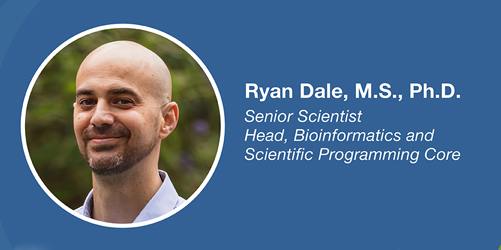 How did you become interested in science and research?
How did you become interested in science and research?
Biology in all its forms and scales, from self-organizing molecules to continent-spanning ecosystems, has always fascinated me. My first research experiences were on the Midwest prairie, studying the interaction of biodiversity and nutrient availability, and the coastal estuaries of Maine, studying huge populations of tiny shrimp that lift off the sea floor in a massive layer each night to feed.
I studied marine ecology and oceanography in graduate school, which involves thinking about systems that are too large to actually see. When I started at NIH working in developmental biology, I learned how to think about systems that are too small to see. It’s a complex world, and biology seems even more complex than other parts of the world—which makes it both a joy and a challenge to study.
What brought you to NICHD?
I had been doing bioinformatics for nine years in the National Institute of Diabetes and Digestive and Kidney Diseases as one person for a group of six labs, and I thought it would be a fun challenge to do the same kind of thing at NICHD—but for more than 60 labs.
What types of training, experiences, or traits are essential for success in your position?
Learning how to learn, so that you can stay on top of the rapidly moving field of bioinformatics. Enjoying puzzles and troubleshooting because much of your time in bioinformatics is spent debugging. Holding the big picture (i.e., why we study this) at the same time as the fine-grained details (e.g., what are the valid parameters to use for this tool) and tying them together (e.g., if I make this change to this parameter, then we can interpret the results this way, and it means this about how a cell works).
What do you find most valuable about working at NICHD?
NICHD researchers study a remarkable diversity of systems, topics, diseases, and processes. Being involved in so many domains of research means that we sometimes find unexpected commonalities that we can use to our advantage across multiple research programs.
What is your favorite research finding out of everything you have worked on?
Not so much a research finding but a tool called Bioconda. Software used to be a huge pain to install; you needed to follow convoluted steps for each of the dozens of software tools you wanted to use. It could take days! And good luck reproducing that elsewhere.
A wonderful tool called conda was released, which is a particular way of installing software packages. An international group of bioinformaticians banded together to package the software we wrote into conda packages to make it easier for people to use. That worked well, and then we realized we could use it for other software. So, we started a collection of packages related to bioinformatics (and lots of surrounding infrastructure) that we called Bioconda.
Fast forward a few years later, and we have thousands of packages available with well over a hundred million downloads and counting. It’s fun to think about how much time we have saved across biomedical research, now that bioinformaticians are spending minutes installing tools for every project instead of days!
What advice can you offer to people who are at an earlier stage of their career?
Science is way more about people than you might think. It’s a small world, and depending on your specialty, it can be a tiny world. Be kind, thoughtful, and helpful; over time, the interest on that can compound into a network of colleagues and collaborators who together can make a large impact.
Return to Get to Know NICHD.
 BACK TO TOP
BACK TO TOP